Von Richthofen and Brown
6.2 /10 1 Votes
Initial DVD release April 24, 2007 Duration Country United States | 6/10 IMDb Genre Action, Biography, Drama Language English | |||||||||||||||||||||||||||||||||
 | ||||||||||||||||||||||||||||||||||
Release date July 28, 1971 (1971-07-28) (US) Cast Similar movies | ||||||||||||||||||||||||||||||||||
The red baron vs hermann goering von richthofen and brown movie clip mgm studios 1971
Von Richthofen and Brown, also known as The Red Baron, is a 1971 war film directed by Roger Corman, and starring John Phillip Law and Don Stroud as the title characters. Although names of real people are used, the story by Joyce Hooper Corrington and John William Corrington makes no claim to be historically accurate, and in fact is largely fictional.
Contents
- The red baron vs hermann goering von richthofen and brown movie clip mgm studios 1971
- Plot
- Production
- Reception
- References
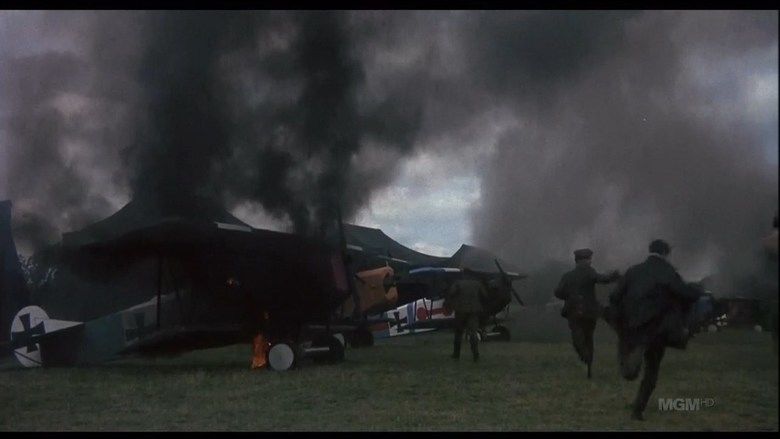
Plot
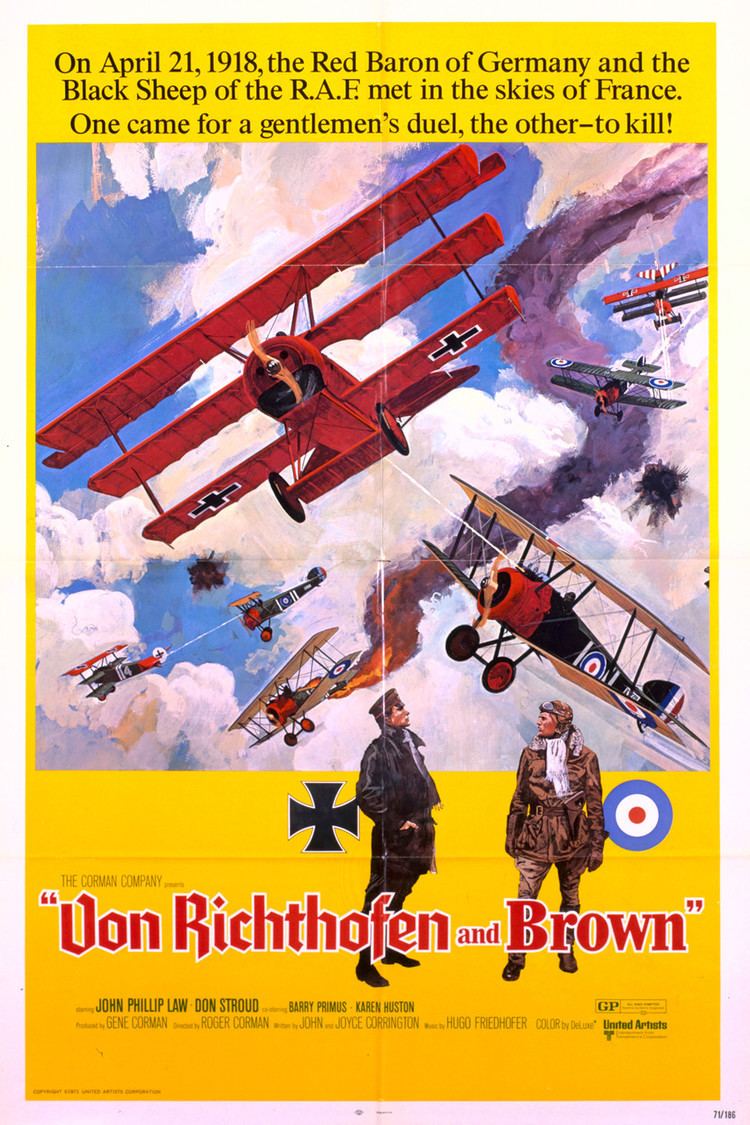
Manfred von Richthofen (John Phillip Law), a German cavalry officer is newly assigned to an air squadron under the command of Oswald Boelcke (Peter Masterson). Across the lines, another pilot, a Canadian named Roy Brown (Don Stroud), arrives at a British squadron under the command of Lanoe Hawker (Corin Redgrave).
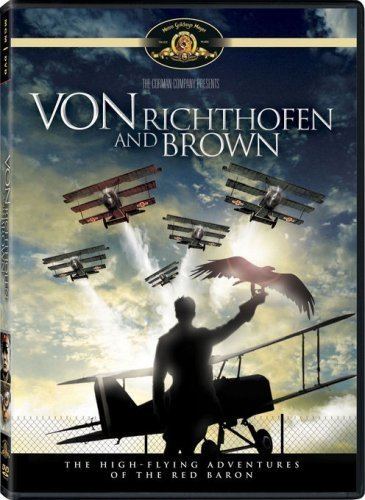
The two pilots are very different; Brown ruffles the feathers of his squadron mates by refusing to drink a toast to Richthofen, while the Baron awards himself silver trophies in honour of his kills, and clashes with fellow pilot Hermann Göring (Barry Primus) when Boelcke is killed after a mid-air collision and Richthofen assumes command of the squadron. Richthofen becomes outwardly energized by the war. Outraged by an order to camouflage his squadron's aircraft, he paints them in bright conspicuous colours, claiming that gentlemen should not hide from their enemies.
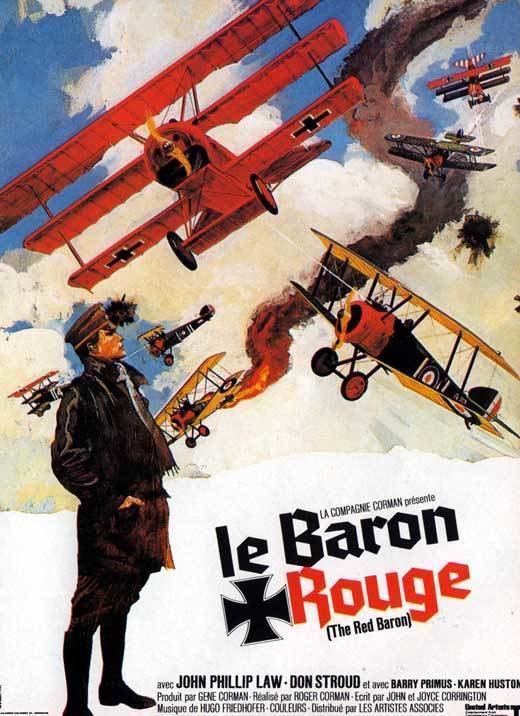
The toll on both squadrons is highlighted when Richthofen is wounded during an aerial battle and Lanoe Hawker is killed. The war becomes personal for both when Brown and his squadron attack Richthofen's airfield, destroying their aircraft on the ground. Revenge comes when Richthofen, with the help of a batch of new fighters from Anthony Fokker (Hurd Hatfield) launches a counterattack on the British airfield. Back at their aerodrome, Richthofen rants at Göring for leaving the formation and strafing medical personnel. He says: "You're an assassin!" Göring defends himself by saying: "I make war to win." Richthofen tells him: "Get out of my sight!", threatening that if Göring does something similar again, he will personally go to the Kaiser to make sure Göring is shot.

Richthofen's passion for the war fades, becoming dismayed and depressed that his squadron is losing so many pilots. He even starts to realize that Germany might lose the war. Caught between his disgust for the war, and the responsibility for his fighter wing, he refuses a job offer from the government deciding to help fight alongside his men, knowing it will probably lead to his death in combat. Brown proves very uncooperative. He says it feels like he has shot down at least 100 German aircraft. He has a rather defeatist attitude and often says that they are all going to die before the war comes to an end.
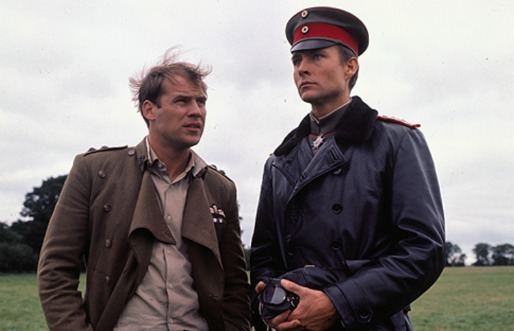
On April 21, 1918, Richthofen and Brown engage in an aerial duel during which Richthofen receives a fatal wound. He is able to land his aircraft, before he dies. The Allied pilots congratulate Brown on downing Richthofen. The pilot who will take over from Richthofen is Göring.
Production

Roger Corman had been interested in making a film about Manfred von Richthofen for a number of years. Corman felt that the Baron was the last true knight, an aristocratic warrior with a code of honor. Corman wanted to show how the Baron's way of thinking was archaic compared to the wholesale slaughter of World War I. Corman also wanted to contrast the Baron with the man who had been credited with shooting him down, Canadian RAF pilot Roy Brown. (Most historians now believe that the Red Baron was shot down by ground fire.)

In 1965 it was announced he had commissioned a script called The Red Baron from Robert Towne. He pitched the project to 20th Century Fox along with the St Valentine's Day Massacre; Fox decided to make the latter, as they already had The Blue Max. Years later Corman signed a deal with United Artists who liked the idea of a film about the Red Baron but did not want the film to be too German, so Corman agreed to make it about the pilot who shot him down as well.
Although the story of the two foes who meet in a fateful last flight, was essentially a historical subject, Corman's intention was to treat the subject as an allegory of the modern war machine in conflict with antiquated old world notions of chivalry.
Corman was able to work with a much larger budget than he enjoyed with his earlier features. Ex-RCAF pilot Lynn Garrison supplied the aircraft, crews and facilities, and personally coordinated the flying sequences; Garrison had purchased the collection of hangars, aircraft, vehicles and support equipment accumulated for filming 20th Century’s top-grossing film, The Blue Max, after the production wrapped in 1965. The collection included replica Pfalz D.IIIs, Royal Aircraft Factory S.E.5s, Fokker D.VIIs, Fokker Dr.Is. A number of de Havilland DH.82A Tiger Moths and Stampe SV.4Cs had also been converted to represent other aircraft, for a total of 12 aircraft available for aerial scenes.
Corman used an Aérospatiale Alouette II helicopter, along with a Helio Courier, for aerial photography, supported by a number of specialized camera mounts Garrison developed for use on individual aircraft. This allowed footage of actors, such as John Philip Law and Don Stroud "flying" the aircraft. Garrison trained Law and Stroud to the point where they could take off, land a Stampe, and fly basic sequences themselves from the rear seat, filmed with a rear-facing camera. Stunt pilots were used for the more complicated sequences, one such being famed New Age author Richard Bach. Bach wrote about his experiences in a short story entitled "I Shot Down the Red Baron, and So What", which is reproduced in his short story collection A Gift of Wings.
Corman used a filming schedule that included so-called "Blue Days, Grey Days and Don’t Give a Damn Days" so that the aircraft were used no matter what the weather presented.
On 15 September 1970, Charles Boddington, a veteran of both The Blue Max and Darling Lili, was killed when his S.E.5 spun in during a low-level manoeuvre over the airfield. The next day, during the last scheduled flight on the shooting schedule, Garrison and Stroud were involved in a low-level sequence across Lake Weston in a Stampe, when a jackdaw struck Garrison in the face, knocking him unconscious. The aircraft then ran through five powerlines, snap rolled and plunged into the River Liffey inverted. Garrison and Stroud were rescued from the water. Stroud was uninjured, but Garrison required 60 stitches to close a head wound. Both incidents occurring in such a short period resulted in Irish authorities grounding the production. Corman lobbied for restoration of flying and a few days later, was successful.
Some of the interior shots in Von Richthofen and Brown were filmed at Powerscourt House, a noted stately home in County Wicklow Ireland. Powerscourt had been designed by Richard Cassels, a German architect, and the entrance hall had a Germanic motif, lending a visual connection to a German location.
Corman felt the pressure of directing a big-budget feature were such that he wanted to take a sabbatical. Although heavily involved as a producer during the interim, he did not direct another film until Frankenstein Unbound (1990).
Reception
Von Richthofen and Brown received mixed to negative reviews from both viewers and critics, although Roger Greenspun, in his review for The New York Times saw Corman's work as "... an extraordinarily impressive movie by a filmmaker whose career has not always been marked by success, or even noble failure." Critics also connected Corman's anti-war views with the central characters of the film, seeing the antagonists as representing the modern relentless killing machine versus old world chivalry.
As an aviation epic, reviewer Leonard Maltin noted, "Aerial work is excellent, it's the ground work which crashes."
References
Von Richthofen and Brown WikipediaVon Richthofen and Brown IMDb Von Richthofen and Brown themoviedb.org
